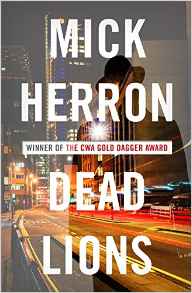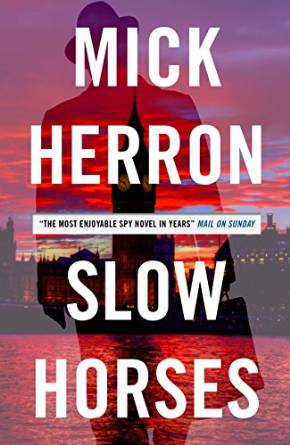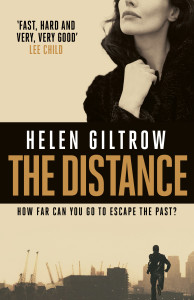Guest Post – Helen Giltrow: Serial Heroes
It is Day Three of my quest to discover which ongoing crime and thriller series my favourite authors look forward to reading.
Thus far Douglas Skelton has shared his love of the Ed McBain 87th Precinct books and Angela Marsons told us why she enjoys Val McDermid’s Tony Hill stories.
Today I am delighted to welcome Helen Giltrow back to Grab This Book. I reviewed Helen’s brilliant thriller The Distance earlier this year and she kindly answered a few of my questions for a Q&A (one of the hardest I have written as The Distance was clever, sophisticated and I was a bit daunted sending questions through to Helen that would not show me up).
When I was planning this week of features I really wanted Helen to take part. Helen attended the Bloody Scotland festival in Stirling earlier this year – she was one of the fabulous Killer Women panel. I managed to catch up with her in the festival bookshop and we traded book recommendations for much longer than most people will talk about books with me! Helen mentioned lots of books and authors that afternoon but one author’s name stood out and her enthusiasm for his books shone through:
HELEN GILTROW:
Mick Herron’s Slough House series
 I wasn’t going to like Mick Herron’s Slough House books. Forget Slow Horses’ shortlisting for the CWA Steel Dagger, and Dead Lions’ Gold Dagger, Best Crime Novel win. Forget the critical acclaim. Forget even the spy-thriller tag, which given that I was raised on Le Carre’s Smiley novels should at least have piqued my interest. On its original (US) paperback cover, Dead Lions was described as ‘a send-up’ and ‘a romp’. I like my crime fiction dark and serious. I nearly didn’t buy it.
I wasn’t going to like Mick Herron’s Slough House books. Forget Slow Horses’ shortlisting for the CWA Steel Dagger, and Dead Lions’ Gold Dagger, Best Crime Novel win. Forget the critical acclaim. Forget even the spy-thriller tag, which given that I was raised on Le Carre’s Smiley novels should at least have piqued my interest. On its original (US) paperback cover, Dead Lions was described as ‘a send-up’ and ‘a romp’. I like my crime fiction dark and serious. I nearly didn’t buy it.
If I hadn’t, this post would have been about another author’s books – Le Carre’s, James Lee Burke’s or Tana French’s. But right now, if there’s one series I would urge you to read – even if you don’t like espionage novels, or consider yourself allergic to books that win awards or get described as romps – it would be Slough House.
Let’s start with the premise. Slough House itself is a dingy central-London office building where the screw-ups of MI5 – men and women the Service no longer wants but can’t afford to sack – are subjected to an unending round of pointless, soul-destroying tasks, in the hope that they’ll resign. Variously alcoholic, addicted, personality-disordered, aggressive, inept, or just plain unlucky, they work under a former field agent, Jackson Lamb, who treats them with spectacular levels of abuse and contempt. But they refuse to leave, hoping that one day, somehow, they’ll get their chance to win their old jobs back …
A different author would simply have used that as the set-up, quickly springing his heroes out of their office prison and into a world that only they can save. Herron doesn’t, instead anchoring his action firmly in Slough House and thus setting out his stall. The international glamour of James Bond, the grimy endurance-test heroics of Jason Bourne? They don’t get a look-in. Here’s a series grounded in a world most of us can recognize – where ordinary, slightly useless, occasionally appalling people work in a horrible office, live in hope … and keep on screwing up.
Of course, there’s still escapist fun to be had, in spades. And great jokes. (The books are properly funny, the sort of funny that’s had me laughing out loud on trains; the dialogue in particular is a joy, packed with one-liners and smarting with noir-ish wit.) There’s gorgeous writing, too – Herron’s prose is lovely – and fiendishly twisty plot construction: some chapters are multiple-viewpoint masterclasses in misdirection and withholding.
And Herron knows his genre. Each book has a strong espionage hook: extremists threatening an innocent with execution in Slow Horses, a mysterious message left by a murdered former agent in Dead Lions, an Intelligence officer held to ransom in the forthcoming Real Tigers. Even so, you can’t help feeling that (as was famously once said of Le Carre’s Tinker, Tailor) they’re ‘not really about spying’.
 What drives them are the characters. And not just the inmates of Slough House – which include River Cartwright, the series’ idealistic hero; the self-deluding hacker Roderick Ho; the unshakeably vile Lamb, whose cartoonish excesses hide a dark past; and Lamb’s recovering-alcoholic PA, the ‘mad governess’ Catherine Standish … A supporting cast spans the whole hierarchy of espionage, from burnt-out former assets and disgraced spies, through the lower ranks, the fixers and enforcers, to the ‘Second Desk’ of MI5, Diana Taverner – sophisticated, treacherous, and permanently at war with her boss Dame Ingrid Tierney – and her political masters.
What drives them are the characters. And not just the inmates of Slough House – which include River Cartwright, the series’ idealistic hero; the self-deluding hacker Roderick Ho; the unshakeably vile Lamb, whose cartoonish excesses hide a dark past; and Lamb’s recovering-alcoholic PA, the ‘mad governess’ Catherine Standish … A supporting cast spans the whole hierarchy of espionage, from burnt-out former assets and disgraced spies, through the lower ranks, the fixers and enforcers, to the ‘Second Desk’ of MI5, Diana Taverner – sophisticated, treacherous, and permanently at war with her boss Dame Ingrid Tierney – and her political masters.
The interchanges between the ranks, the jockeyings for advantage at every level, strike sparks that light these books. More than anything else these are stories about people, and the inequalities of power.
I guess that’s why I object to ‘romp’ so much – and ‘send-up’, and ‘caper’ too. For me, those terms imply not just a knowing smugness in the writing but also a frivolousness: it’s all right, it’s just a game. Herron knows its isn’t, especially when lives are at stake, or power is being abused. However fabulously entertaining the Slough House books are, they’re serious too, shot through with quiet tragedy, courage, grief, even tenderness; occasionally, anger. For all the energy, the wit, the stylistic fireworks, there’s a bedrock awareness of real-world issues in these books, a restrained seriousness behind the jokes, an intentness of purpose that I really, really like.
The Slough House series is good, and getting even better. I recommend you read it.
Slow Horses and Dead Lions are available in paperback, published by John Murray; they are also part of this month’s (December 2015) Kindle Deals, at 99p each.
The spin-off novel Nobody Walks – shortlisted for this year’s CWA Steel Dagger – has just been published in paperback by Soho Press.
The next Slough House book, Real Tigers, comes out in February 2016.
Visit Mick Herron’s Amazon page to see all his books and pick up any which take your fancy: http://www.amazon.co.uk/Mick-Herron/e/B001JP3TOY/ref=sr_tc_2_0?qid=1450304380&sr=8-2-ent
 Helen’s Amazon page is here: http://www.amazon.co.uk/Helen-Giltrow/e/B00J40VGW8/ref=sr_ntt_srch_lnk_1?qid=1450304539&sr=8-14
Helen’s Amazon page is here: http://www.amazon.co.uk/Helen-Giltrow/e/B00J40VGW8/ref=sr_ntt_srch_lnk_1?qid=1450304539&sr=8-14
I reviewed Helen’s brilliant thriller The Distance earlier this year and you can read my review: The Distance Helen also joined me for a Q&A when The Distance was released in paperback.

